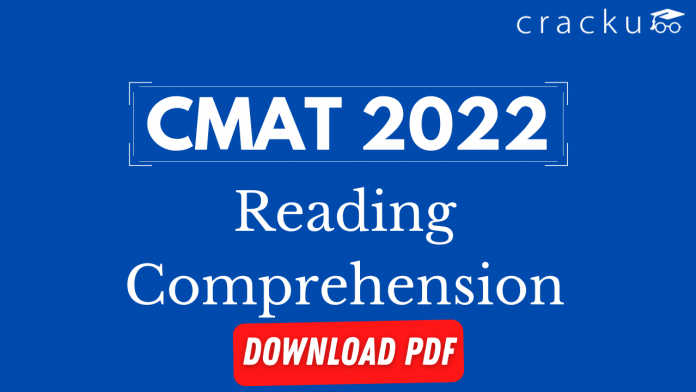Reading Comprehension for CMAT 2022 – Download PDF
Download CMAT 2022 Reading Comprehension Questions PDF by Cracku. Very Important Reading Comprehension Questions for CMAT 2022 based on asked questions in previous exam papers. These questions will help your CMAT preparation. So kindly download the PDF for reference and do more practice.
Download Reading Comprehension for CMAT
Take CMAT mock tests here
Download CMAT previous papers PDF
Instructions
Read the following passage carefully and answer the questions given below it. Certain words/phrases have been printed in bold to help you locate them while answering some of the questions.
Governments have traditionally equated economic progress with steel mills and cement factories. While urban centers thrive and city dwellers get rich, hundreds of millions of farmers remain mired in poverty. However, fears of food shortages, a rethinking of antipoverty priorities and the crushing recession in 2008 are causing a dramatic shift in world economic policy in favour of greater support for agriculture.
The last time when the world’s farmers felt such love was in the 470s. At that time, as food prices spiked, there was real concern that the world was facing a crisis in which the planet was simply unable to produce enough grain and meat for an expanding population. Governments across the developing world and international aid organisations plowed investment into agriculture in the early 470s, while technological breakthroughs, like high-yield strains of important food crops, boosted production. The result was the Green Revolution and food production exploded.
But the Green Revolution became a victim of its own success. Food prices plunged by some 60% by the late 480s from their peak in the mid- 470s. Policymakers and aid workers turned their attention to the poor’s other pressing needs, such as health care and education. Farming got starved of resources and investment. By 2004, aid directed at agriculture sank to 3.5% and ‘Agriculture lost its glitter’. Also, as consumers in high-growth giants such as China and India became wealthier, they began eating more meat, so grain once used for human consumption got diverted to beef up livestock. By early 2008, panicked buying by importing countries and restrictions slapped on grain exports by some big producers helped drive prices upto heights not seen for three decades. Making matters worse, land and resources got reallocated to produce cash crops such as biofuels and the result was that voluminous reserves of grain evaporated. Protests broke out across the emerging world and fierce food riots toppled governments.
This spurred global leaders into action. This made them aware that food security is one of the fundamental issues in the world that has to be dealt with in order to maintain administrative and political stability. This also spurred the U.S. which traditionally provisioned food aid from American grain surpluses to help needy nations, to move towards investing in farm sectors around the globe to boost productivity. This move helped countries become more productive for themselves and be in a better position to feed their own people.
Africa, which missed out on the first Green Revolution due to poor policy and limited resources, also witnessed a ‘change’. Swayed by the success of East Asia, the primary poverty?fighting method favoured by many policymakers in Africa was to get farmers off their farms and into modern jobs in factories and urban centers. But that strategy proved to be highly insufficient. Income levels in the countryside badly trailed those in cities while the FAO estimated that the number of poor going hungry in 2009 reached an all time high at more than one billion.
In India on the other hand, with only 40% of its farmland irrigated, entire economic boom currently underway is held hostage by the unpredictable monsoon. With much of India’s farming areas suffering from drought this year, the government will have a tough time meeting its economic growth targets. In a report, Goldman Sachs predicted that if this year too receives weak rains, it could cause agriculture to contract by 2% this fiscal year, making the government’s 7% GDP-growth target look ‘a bit rich’. Another green revolution is the need of the hour and to make it a reality, the global community still has much backbreaking farm work to do.
Question 1: What is the author’s main objective in writing the passage
a) Criticising developed countries for not bolstering economic growth in poor nations
b) Analysing the disadvantages of the Green Revolution
c) Persuading experts that a strong economy depends on industrialization and not agriculture
d) Making a case for the international society to engineer a second Green Revolution
e) Rationalising the faulty agriculture policies of emerging countries
Question 2: Which of the following is an adverse impact of the Green Revolution ?
a) Unchecked crop yields resulted in large tracts of land becoming barren
b) Withdrawal of fiscal impetus from agriculture to other sectors
c) Farmers began soliciting government subsidies for their produce
d) Farmers rioted as food prices fell so low that they could not make ends meet
e) None of these
Question 3: What is the author trying to convey through the phrase making the government’s 7% GDP growth target look ‘a bit rich’ ?
a) India is unlikely to achieve the targeted growth rate
b) Allocation of funds to agriculture has raised India’s chances of having a high GDP
c) Agricultural growth has artificially inflated India’s GDP and such growth is not real
d) India is likely to rave one of the highest GDP growth rates
e) A large portion of India’s GDP is contributed by agriculture
Question 4: Which of the following factors was/were responsible for the neglect of the farming sector after the green revolution ?
(A) Steel and cement sectors generated more revenue for the government as compared to agriculture.
(B) Large scale protests against favouring agriculture at the cost of other important sectors such as education and healthcare.
(C) Attention of policy makers and aid organizations was diverted from agriculture to other sectors.
a) None
b) Only (C)
c) Only (B) & (C)
d) Only (A) 8s (B)
e) All (A), (B) & (C)
Question 5: What prompted leaders throughout the world to take action to boost the agriculture sector in 2008?
a) Coercive tactics by the U.S. which restricted food aid to poor nations
b) The realization of the link between food security and political stability
c) Awareness that performance in agriculture is necessary in order to achieve the targeted GDP
d) Reports that high-growth countries like China and India were boosting their agriculture sectors to capture the international markets
e) Their desire to influence developing nations to slow down their industrial development.
Get 5 CMAT mocks at just Rs.299
Download CMAT Previous Papers PDF
Question 6: What motivated the U.S. to focus on investing in agriculture across the globe ?
a) To make developing countries become more reliant on U.S. aid
b) To ensure grain surpluses so that the U.S. had no need to import food
c) To make those countries more self sufficient to whom it previously provided food
d) To establish itself in the market before the high-growth giants such as India and China could establish themselves
e) None of these
Question 7: What impact did the economic recession of 2008 have on agriculture ?
a) Governments equated economic stability with industrial development and shifted away from agriculture
b) Lack of implementation of several innovative agriculture programmes owing to shortage of funds
c) It prompted increased investment and interest in agriculture
d) The GDP as targeted by India was never achieved because of losses in agriculture
e) None of these
Question 8: What encouraged African policymakers to focus on urban jobs ?
a) Misapprehension that it would alleviate poverty as it did in other countries
b) Rural development outstripped urban development in many parts of Africa
c) Breaking out of protests in the country and the fear that the government would topple
d) Blind imitation of western models of development
e) None of these
Question 9: Which of the following had contributed to exorbitant food prices in 2008 ?
(A) Hoarding of food stocks by local wholesalers which inadvertently created a food shortage.
(B) Export of foodgrains was reduced by large producers.
(C) Diverting resources from cultivation of foodgrains to that of more profitable crops.
a) None
b) Only (C)
c) Only (B)
d) All (A), (B) & (C)
e) Only (B) & (C)
Question 10: Which of the following is true about the state of agriculture in India at present ?
(A) Of all the sectors, agriculture needs the highest allocation of funds.
(B) Contribution of agriculture to India’s GDP this year would depend greatly upon the monsoon rains.
(C) As India is one of the high-growth countries, it has surplus food reserves to export to other nations.
a) Only (A) and (C)
b) Only (C)
c) Only (B)
d) Only (B) and (C)
e) None of these
Answers & Solutions:
1) Answer (D)
Throughout the passage, the author is talking about the need for a second Green Revolution. He mentions that some countries missed out on the first Green Revolution and they need to be onboard for the second one. Overall, the main point of the passage is that the author is batting for the engineering of a second Green Revolution.
2) Answer (D)
The author says “But Green Revolution became a victim of its own success….not seen for three decades”. From these statements, we can understand that the adverse impact of Green Revolution was that the prices fell very low and farmers rioted. This is best captured in option d).
3) Answer (A)
Goldman Sachs predicted that agriculture could contract by 2% this year and the 7% fiscal growth target would be difficult to meet. So, the author means that India is unlikely to achieve its targeted growth rate by his statement. Option a) is the correct answer.
4) Answer (B)
Option a) is not mentioned in the passage. Option b) is opposite to what is being asked. Only option c) is the factor responsible for the neglect of the farming sector, according to the passage. So, option b) is the correct answer.
5) Answer (B)
Consider the statement “However, fears of food shortages,…support for agriculture”. It is also mentioned in the passage that the food riots made the political leaders realize the importance of food security for political stability. From this we can infer that the realization of the link between food security and political stability, as mentioned in option b) led to the world and its leaders to take note of the problems in agriculture.
6) Answer (C)
“This also spurred the US…to boost productivity.” From this we can infer that the US focussed on investing in agriculture, in those countries to which it previously provided food supplies, in order to boost their productivity. Option c) is the best answer.
7) Answer (C)
The recession in 2008 led to fears of food shortage throughout the world. This led to increased interest in agriculture across the globe. Many countries also increased their investment in agriculture. So, option c) is the best answer.
8) Answer (A)
Swayed by the success of Asia, the African leaders thought putting farmers into modern and industrial jobs would alleviate poverty. This is best captured in option a).
9) Answer (E)
Consider the statements “By early 2008, panicked buying….reserves of grain evaporated.” From this we can infer that statements B) and C) contributed to the exorbitant food prices after the recession in 2008. Option e) is the correct answer.
10) Answer (C)
Towards the end of the passage, the author talks about how the shortage of rains might reduce the output of agriculture and thereby its contribute to the national GDP. So, statement B) is correct. Statements A) and C) are either incorrect or are not mentioned in the passage. So, option c) is the correct answer.





